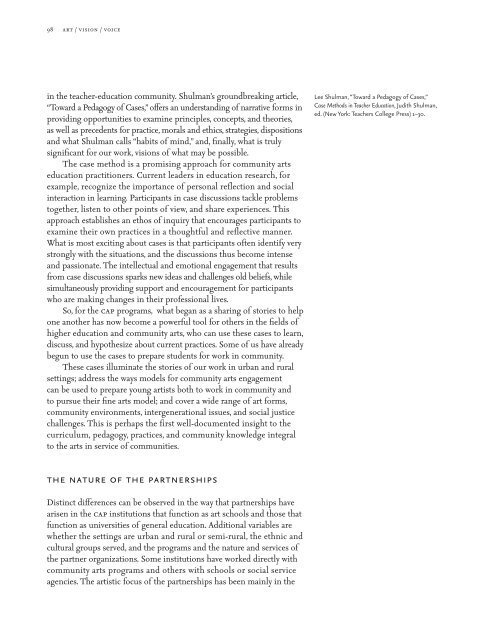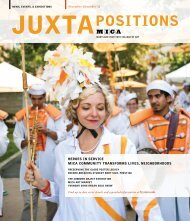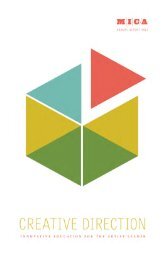art/vision/voice - Maryland Institute College of Art
art/vision/voice - Maryland Institute College of Art
art/vision/voice - Maryland Institute College of Art
You also want an ePaper? Increase the reach of your titles
YUMPU automatically turns print PDFs into web optimized ePapers that Google loves.
98 <strong>art</strong> / <strong>vision</strong> / <strong>voice</strong><br />
in the teacher-education community. Shulman’s groundbreaking <strong>art</strong>icle,<br />
“Toward a Pedagogy <strong>of</strong> Cases,” <strong>of</strong>fers an understanding <strong>of</strong> narrative forms in<br />
providing opportunities to examine principles, concepts, and theories,<br />
as well as precedents for practice, morals and ethics, strategies, dispositions<br />
and what Shulman calls “habits <strong>of</strong> mind,” and, finally, what is truly<br />
significant for our work, <strong>vision</strong>s <strong>of</strong> what may be possible.<br />
The case method is a promising approach for community <strong>art</strong>s<br />
education practitioners. Current leaders in education research, for<br />
example, recognize the importance <strong>of</strong> personal reflection and social<br />
interaction in learning. P<strong>art</strong>icipants in case discussions tackle problems<br />
together, listen to other points <strong>of</strong> view, and share experiences. This<br />
approach establishes an ethos <strong>of</strong> inquiry that encourages p<strong>art</strong>icipants to<br />
examine their own practices in a thoughtful and reflective manner.<br />
What is most exciting about cases is that p<strong>art</strong>icipants <strong>of</strong>ten identify very<br />
strongly with the situations, and the discussions thus become intense<br />
and passionate. The intellectual and emotional engagement that results<br />
from case discussions sparks new ideas and challenges old beliefs, while<br />
simultaneously providing support and encouragement for p<strong>art</strong>icipants<br />
who are making changes in their pr<strong>of</strong>essional lives.<br />
So, for the cap programs, what began as a sharing <strong>of</strong> stories to help<br />
one another has now become a powerful tool for others in the fields <strong>of</strong><br />
higher education and community <strong>art</strong>s, who can use these cases to learn,<br />
discuss, and hypothesize about current practices. Some <strong>of</strong> us have already<br />
begun to use the cases to prepare students for work in community.<br />
These cases illuminate the stories <strong>of</strong> our work in urban and rural<br />
settings; address the ways models for community <strong>art</strong>s engagement<br />
can be used to prepare young <strong>art</strong>ists both to work in community and<br />
to pursue their fine <strong>art</strong>s model; and cover a wide range <strong>of</strong> <strong>art</strong> forms,<br />
community environments, intergenerational issues, and social justice<br />
challenges. This is perhaps the first well-documented insight to the<br />
curriculum, pedagogy, practices, and community knowledge integral<br />
to the <strong>art</strong>s in service <strong>of</strong> communities.<br />
the nature <strong>of</strong> the p<strong>art</strong>nerships<br />
Distinct differences can be observed in the way that p<strong>art</strong>nerships have<br />
arisen in the cap institutions that function as <strong>art</strong> schools and those that<br />
function as universities <strong>of</strong> general education. Additional variables are<br />
whether the settings are urban and rural or semi-rural, the ethnic and<br />
cultural groups served, and the programs and the nature and services <strong>of</strong><br />
the p<strong>art</strong>ner organizations. Some institutions have worked directly with<br />
community <strong>art</strong>s programs and others with schools or social service<br />
agencies. The <strong>art</strong>istic focus <strong>of</strong> the p<strong>art</strong>nerships has been mainly in the<br />
Lee Shulman, “Toward a Pedagogy <strong>of</strong> Cases,”<br />
Case Methods in Teacher Education, Judith Shulman,<br />
ed. (New York: Teachers <strong>College</strong> Press) 1–30.
















